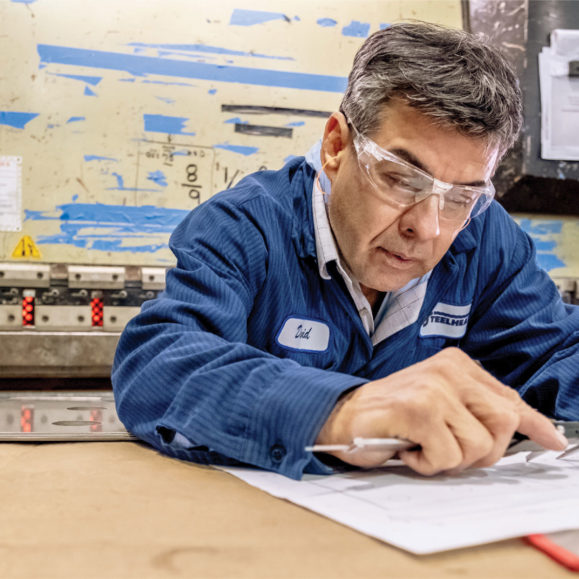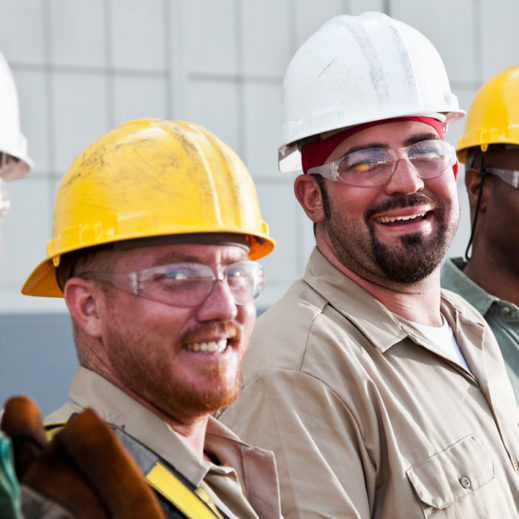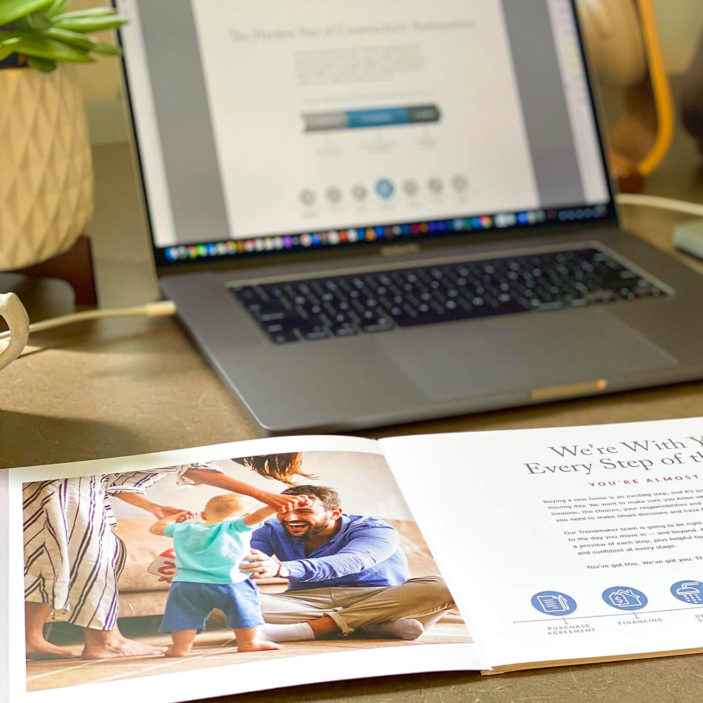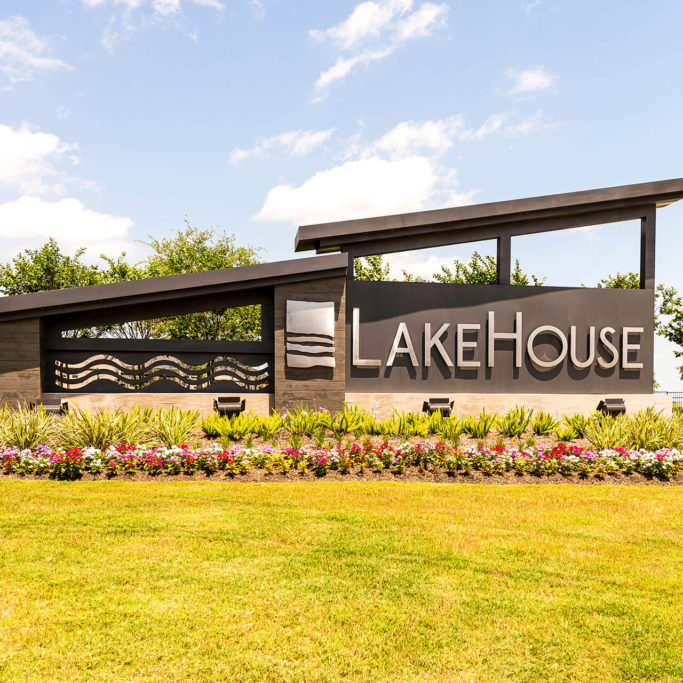Texas Mutual Insurance Company, Texas’ leading workers’ compensation provider and a champion of employee safety, wanted to put safety resources at its policyholders’ fingertips, beginning with the construction industry. They literally asked us to figure out how to put safety in a box. That’s exactly what we did.
Preventing Accidents by Thinking INSIDE the Box
A Whole New Way to Look at Safety
“I can count on the team at Wick to go beyond the easy or obvious solution and dig deeper for a more creative, unexpected way to tackle a challenge.”JEREMIAH BENTLEY
VP of Marketing and Community Affairs
Challenges
Texas Mutual needed a compelling and effective safety training solution that could be broadly distributed—snail mail was part of the original plan—and accessible from any location, since so many construction workers are out in the field. In addition, whatever we came up with would need to appeal to younger workers who were not engaging with traditional safety training resources. Other challenges included making the resource adaptable to a variety of industries, including both English and Spanish options and managing to a budget.
Insights
Research indicated that the four most common causes of workplace fatalities for construction workers, the “fatal four,” as they’re known in the industry, are: being struck by an object; falling from height; electrocution; and being caught in or between objects. In the manufacturing industry, workplace fatalities occur most frequently around lockout/tagout procedures when working with automated equipment; slip/trip and fall injuries; and working safely around a forklift.
Virtual Reality (VR) could put people in deadly situations, conveying the dangers of specific scenarios without anyone getting hurt. A gamified approach could engage younger workers, as well as those with more tenure, in a new way. It was just convenient that a common VR viewing apparatus—Google Cardboard—happened to essentially be a box.
Virtual Reality (VR) could put people in deadly situations, conveying the dangers of specific scenarios without anyone getting hurt. A gamified approach could engage younger workers, as well as those with more tenure, in a new way. It was just convenient that a common VR viewing apparatus—Google Cardboard—happened to essentially be a box.
Our Roles
- Research
- Creative Concepting
- Script Development
- Art Direction and Production
- VR Videography
- App Development
- Logo Design
- Website Design
- Package Design
- Talent Coordination
- Event Support
Strategy
The solution was an industry-specific VR experience packaged with an easily distributed, affordable Google Cardboard viewer. Real-life accident scenarios in this VR format convincingly helped users to better understand potential risks, and often fatal outcomes. By allowing workers to “experience” a potentially deadly accident without injury, they learned more about how to stay safe on the job.
Rather than animate the “fatal four” scenarios using 3D modeling, we hired a team experienced in 360-degree photography and filmed all four scenarios on actual construction sites as if the camera were the worker. We also cast actors to speak on set in both English and Spanish to communicate the seriousness of the imminent danger. Additionally, an interactive quiz was created at the end of each scenario to enhance the program’s use as a training tool. The final step was to edit the footage and develop an app that was made available for both Apple and Google devices.
The Google Cardboard “box” was then mailed to more than 3,000 policyholders in the construction industry along with instructions on how to download the app and use in safety training. These processes were repeated when the team produced a second program focusing on the manufacturing industry, which was mailed to another 3,000 policyholders.
Rather than animate the “fatal four” scenarios using 3D modeling, we hired a team experienced in 360-degree photography and filmed all four scenarios on actual construction sites as if the camera were the worker. We also cast actors to speak on set in both English and Spanish to communicate the seriousness of the imminent danger. Additionally, an interactive quiz was created at the end of each scenario to enhance the program’s use as a training tool. The final step was to edit the footage and develop an app that was made available for both Apple and Google devices.
The Google Cardboard “box” was then mailed to more than 3,000 policyholders in the construction industry along with instructions on how to download the app and use in safety training. These processes were repeated when the team produced a second program focusing on the manufacturing industry, which was mailed to another 3,000 policyholders.












Results
This resource leveraged new technology to reimagine safety training in a more convenient, more engaging form. Since its introduction in 2016, the Safety in a Box system has become a focal point of Texas Mutual Insurance Company’s workplace safety initiatives.
Safety in a Box received outstanding reviews from the technology and business communities and has became a highly sought after training device. The system was spotlighted in a variety of media, including Insurance Business Magazine, KVUE, Corpus Christi Business News, Captive Insurance News and Austin American-Statesman. The tool has helped support Texas Mutual’s reputation as an innovator in the insurance industry.
Safety in a Box earned Texas Mutual several industry awards, including WorkCompCentral’s Comp Laude Award, SMA Innovation in Action Award, and an honorable mention in the PR News Social Media Awards.
Thousands of Safety in a Box kits have been distributed to policyholders, as well as to attendees at the company’s acclaimed Work Safe, Texas Summits. Most importantly, as employers share the program with workers across the state, it’s helping prevent workplace accidents and save lives.
Safety in a Box received outstanding reviews from the technology and business communities and has became a highly sought after training device. The system was spotlighted in a variety of media, including Insurance Business Magazine, KVUE, Corpus Christi Business News, Captive Insurance News and Austin American-Statesman. The tool has helped support Texas Mutual’s reputation as an innovator in the insurance industry.
Safety in a Box earned Texas Mutual several industry awards, including WorkCompCentral’s Comp Laude Award, SMA Innovation in Action Award, and an honorable mention in the PR News Social Media Awards.
Thousands of Safety in a Box kits have been distributed to policyholders, as well as to attendees at the company’s acclaimed Work Safe, Texas Summits. Most importantly, as employers share the program with workers across the state, it’s helping prevent workplace accidents and save lives.
Takeaways
Know your audience
By focusing on a specific audience, the team was able to develop an entirely new means of capturing their attention and delivering a valuable training message.
Cross-promote
In addition to its primary function as a safety training tool, Safety in a Box has become a sought-after resource at the Work Safe Texas Summits, a series of safety seminars conducted in cities around the state.
Go beyond
To support Texas Mutual’s brand as an innovative, forward-thinking company, the team moved beyond traditional advertising media and collaborated with strong partners to deliver a game-changing solution.
Focus on results
From the beginning, the goal was to provide workers with an easily accessible tool that not only motivated them to work safe, but clearly demonstrated the consequences of unsafe practices. The team’s overarching objective was to effectively improve worker safety and reduce on the job accidents.
More Projects

CASE STUDY
New Strategic Campaign Aligns Customer and Brand Values

CASE STUDY
Consumer-Centric Guidebook Differentiates 55+ Community

CASE STUDY
How Research Informed an Important New Video Storytelling Strategy

CASE STUDY
Strategic Brand Approach Repositions 55+ Community for Success

CASE STUDY
Achieving Presales Results Without Sales Office or Models

CASE STUDY
Single-Family Marketing Strategies Exceed Multi-Family Lease-Up Goals

CASE STUDY
Bringing New Energy to a Multi-Industry Campaign

CASE STUDY
Pivoting in a Pandemic Minute

CASE STUDY
Creating Brand Presence by Being Present

CASE STUDY
Building Trust to Bring Home Sales

CASE STUDY
Making Impressions –
688K+ of Them

CASE STUDY